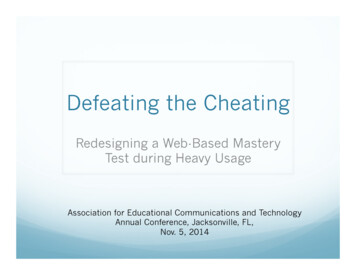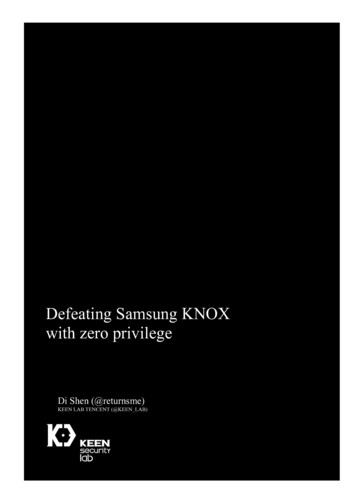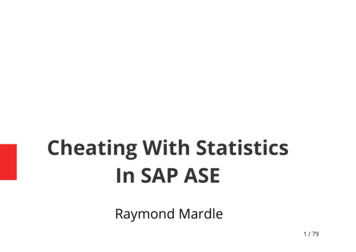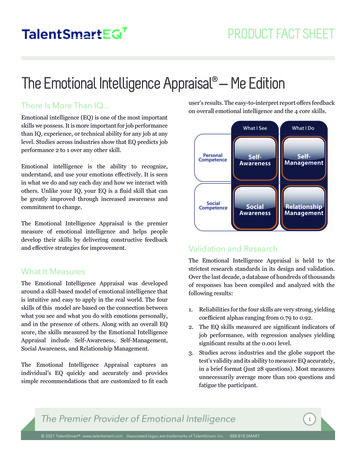
Transcription
Defeating the CheatingRedesigning a Web-Based MasteryTest during Heavy UsageAssociation for Educational Communications and TechnologyAnnual Conference, Jacksonville, FL,Nov. 5, 2014
How to Recognize Plagiarism:Online Tutorial and TestTheodore FrickAndrew BarrettCesur DagliRod Myers(Further contributors past 12 years: Meltem Albayrak-Karahan, Elizabeth Boling,Joseph Defazio, Muruvvet Demiral Uzan, Funda Ergulec, Retno Hendyranti, NorikoMatsumura, Olgun Sadik, Kei Tomita, Carol Watson, and others)Department of Instructional Systems TechnologySchool of Education, Indiana University Bloomington
Overview History of IU Plagiarism Tutorial and Test: 2002 2012 Widespread cheating documented: 2012-13 New Tests Developed: 2013 Primary Level Advanced Level Further enhancements to tutorial: 2014
History of IU PlagiarismTutorial and Test:2002 - 2012
Initial Tutorial and Test Requested by IST Department Chair for master’sand doctoral students Designed and developed in Frick’s advancedproduction class in IST in spring 2002 Since used as part of new student orientation
Website in 2003
Website in 2003
View in 034602/http://www.indiana.edu/ istd/
We did it for ourselves, but Other departments at IU started using it Other universities and schools also started using it—world-wide No advertising—folks found our website on the Web How to Recognize Plagiarism has morphed into a: MOO-Tutorial MOO-Test(MOO: Massively Open Online - )
Exponential Growth in UsageWebsite Requests for IU Plagiarism Tutorial and 00301,000,0002,000,0003,000,0004,000,0005,000,000* 2014: website requests for first 9 months only6,000,0007,000,0008,000,000
Widespread CheatingDocumented2012-13
Website Log in 2012Listing files with at least 0.1% of the requests, sorted by the number ofrequests.no.: reqs: %reqs: Gbytes: %bytes: file---: -------: ------: ------: ------: ---1: 784,538: 20.04%: 0.63: 1.85%: https://www.indiana.edu/ istd/plag.phtml2: 661,811: 16.90%: 3.96: 11.66%: https://www.indiana.edu/ istd/certificate.phtml3: 300,865: 7.68%: 10.85: 31.93%: https://www.indiana.edu/ istd/plagiarism test.html 785,000 test evaluations (plag.phtml) 662,000 “passed” the test (received Certificate)But 301,000 viewed the test (plagiarism test.html)Clear evidence of use of browser BACK button to pass
Instructors Reported Cheating Sent e-mail about YouTube video with answers to IUPlagiarism Test In July, 2013, the order of 10 test items waschanged New answer key soon appeared in YouTube videocomments Every time we changed the item order, a new answerkey was posted soon afterwards
New Tests DevelopedJune - Aug. 2013
New Test Item Pool CreatedUsed computerized classification testing (CCT) todetermine mastery or non-mastery in recognizingplagiarism and non-plagiarism More difficult questions than before Very large item pool Variable-length CCT Items randomly selected, administered one at a time Test ends as soon as decision made with 95% confidence 8-12 items typically required for mastery decision As few as 4 items needed for nonmastery decision Gazillions of unique tests ( 3 x 1024) Done in conjunction with a planned research study
Trial by Fire Launched new CCT on recognizing plagiarism on August16, 2013 Approximately 90,000 CCT administrations in 5 days Just over 5,000 people passed the CCT Complaints via e-mail Test too hard, different from before Small percentage of users reported technical problems Could not register Unable to complete test (crashed)
IRB Concerns about Minors Some minors were taking the new test (under 18years of age) Several parent complaints to IRB about the newtest New test turned off on 5th day Old 10-item test restored Interim solutions considered
Interim Changes to Old Testand TutorialAug. – Sept. 2013
Direct Feedback Loop betweenUsers and Developers Link to send e-mail to developers on almost everyweb page E-mail auto-forwarded to a Google Group (private) Helped developers: Understand user concerns Analyze trends
Changes in Original10-item Certification Test More new items created Easier than the CCT test Went live Labor Day weekend, 2013 One attempt allowed for each Certification Test To prevent multiple attempts at same test 10 items randomly selected Feedback on types of mistakes provided after test (tomake it harder to build answer keys) Billions (not gazillions) of unique tests
Changes in Original10-item Test Specific items missed and number correct no longerprovided after test Only one attempt allowed for each unique test To make it harder to create answer keys for cheating But users complained; could no longer use BACK buttonstrategy; wanted to know which questions they missed Instead, types of errors made were described in testfeedback; and practice tests with feedback on questionsmissed were created Only one attempt allowed for each unique test, toprevent BACK button strategy for improving testoutcome
Further Test Enhancements If a test was passed, a unique Certificate was: E-mailed to student Displayed in browser for printing or screen capture Each Certificate contained: User nameUnique test IDIP address of device usedDate and timeTest duration
Tutorial Enhancements New practice tests added 3 items randomly selected1,100 unique practice testsSimilar to Certification TestsCan be repeated many times Specific feedback given for each question onpractice test Correct or not If not, explanation of why
WayBackMachineOct. ps://www.indiana.edu/ istd/
Meanwhile: Changes toAdvanced-Level CCTAug. 2013 – Jan. 2014
Met with IRB Director andAgreed on Changes There is no practical way to control who accesses thetutorial and test—anyone can Main issue was minors who might access the tests Agreed to change introductory screens to clarify choicebetween Advanced level test (for research) Harder items Variable-length CCT Primary level test (not for research) Easier items For undergrads and those under 18 Newly created 10-item tests with random selection
Advanced-Level CCT Changes Introductory screens changed and IRB approved Minors routed to easier Certification Test Implemented advanced test Dec. 2013, when usage was lighter Ready for big surge in early 2014 More detail provided at AECT featured research session: Facilitating Variable-Length Computerized ClassificationTesting In Massively Open Online Contexts Via AutomaticRacing Calibration Heuristics Friday Nov. 7: 9:15 a.m., 2nd Level, Grand 7
Tutorial and TestEnhancementsAug. 2014 – Sept. 2014
Enhancements in 2014 Added important feature for validating CertificationTest (Primary Level) Instructors can check validity of Certificates,especially those with same Test ID’s but differentstudent names and e-mails Students can retrieve their (lost) Certificates
Test Certificate Validation:Example
Enhanced Instruction andFeedback on Tests Identified 15 patterns of plagiarism and providednew examples in tutorial—to help students betterunderstand their mistakes If test is not passed, more specific feedback nowprovided on what specific patterns were missed ontest Color coding added throughout tutorial to helpstudents identify specific components ofplagiarism and non-plagiarism
Example of New Feedback
Example of “Crafty Cover-Up”Pattern with Color Coding
Results of Changes Less cheating now (based on observations of test logs) No new test answer keys found on Web (gazillions ofunique tests now possible due to random selection fromlarge item pools) Students now know that their instructors can check thevalidity of their Certificates Far less e-mail expressing concerns about lostCertificates, since students themselves can now checkvalidity and get new copies of their Certificates Fewer test attempts needed to pass (passing rate hasincreased 141% in past 3 months)
Future Changes Planned2015
Future Plans Redesign tutorial and tests using First Principles ofInstruction Record temporal maps on how students use variousparts of the tutorial and how they perform on tests Do APT (Analysis of Patterns in Time) to identifyuses of tutorial and associated learning outcomes—i.e., when more first principles and academiclearning time are experienced, is the subsequentlikelihood of mastery greater? Plan to be ready by summer 2015
Thank youVisit the current site:How to Recognize Plagiarismhttps://www.indiana.edu/ istd/History of Recent Changeshttps://www.indiana.edu/ istd/recentChanges.html
plagiarism and non-plagiarism ! More difficult questions than before ! Very large item pool ! Variable-length CCT ! Items randomly selected, administered one at a time ! Test ends as soon as decision made with 95% confiden











